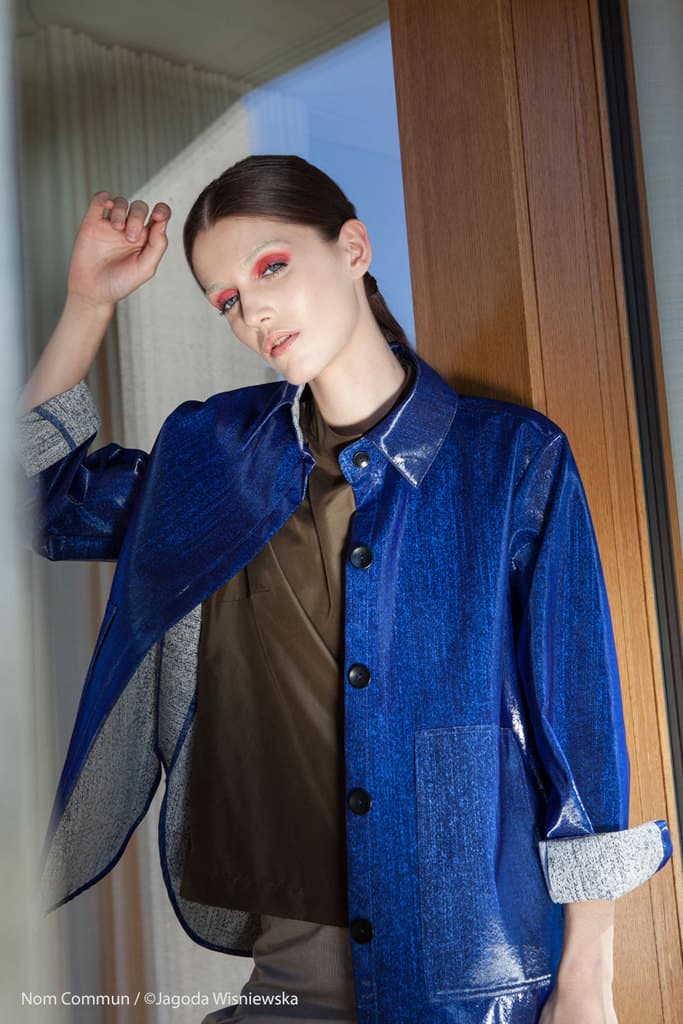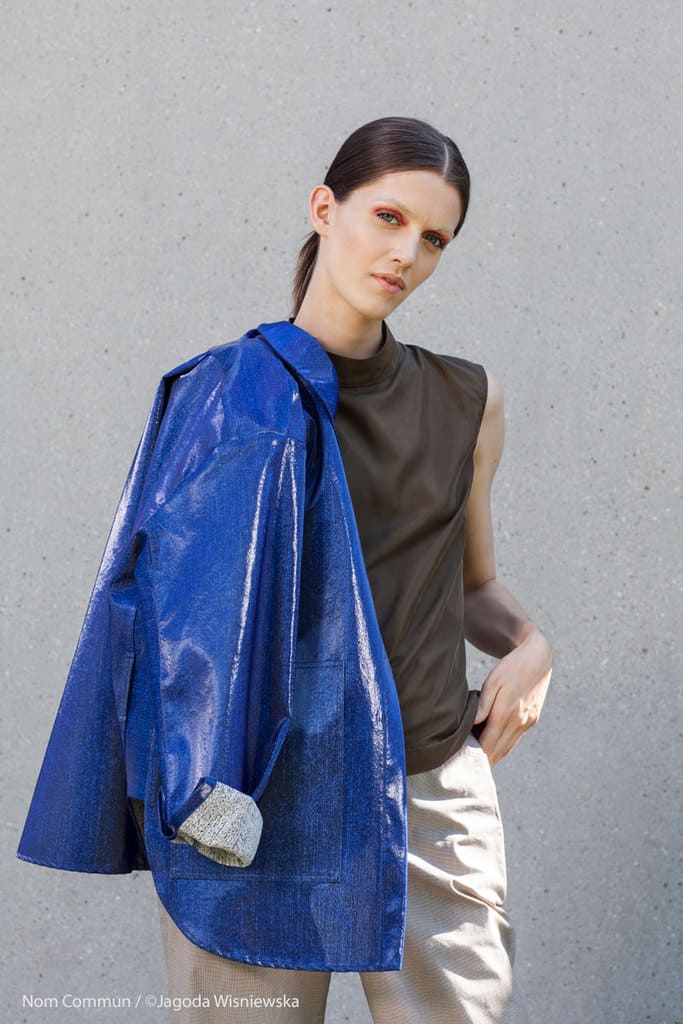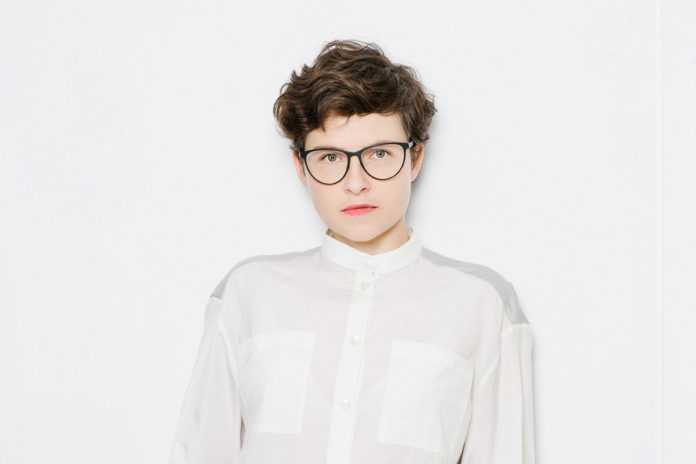Switzerland is an amazing country where we can find outstanding talents in different domains from fashion to gastronomy and even design. Switzerland represents a true identity made of precision, quality, and attachment to heritage. These words are the promises of a great future for any business. This week, meet Mélisande Grivet, the beautiful mind behind the fashion brand Nom Commun. With a first name that can only inspire passion and creativity, Mélisande Grivet is a very talented fashion creator whose fashion is contemporary, sharp, distinctive, and responsible. Her brand, Nom Commun, is a story of clothing and materials wrapped into a lot of talent. She played the game of our interview, enjoy it.
(Pour la version française, cliquez ici.)
LuxuryActivist (LA): How did your passion for fashion start?
Mélisande Grivet (MG): Hard to say. As far as I can remember, I have always had something to do with clothes and sewing. My paternal grandmother had a very coquettish taste, she transmitted this attention to clothes to me. That said, I’m more interested in clothing and tailoring techniques than fashion itself. Fashion goes on, clothes and skills remain. At sixteen, I started working with a seamstress who was doing semi-measures in Nyon. I went there after school and on weekends. This is probably where my passion was revealed and I decided to make it my job.


LA: You were born in Lausanne. Switzerland has incredible talents that are sometimes less known to the general international public. Are your origins an influence in your work? If so, how does this translate? Is it important?
MG: I grew up between the foot of Jura mountains, Lausanne, and Nyon. I am Swiss, but I also have Italian nationality through my mother. I think I have taken rigor, precision, and discretion from Switzerland. As well as a certain approach to design. I did not speak Italian when I was little, but I bathed in this language. After my apprenticeship as a seamstress in a company, I decided to continue my studies in Ticino with the desire to learn Italian and to get closer to this country. I’m still very close to Italy. There is an art of living that influences me a lot and is felt in my way of creating. It was also between Ticino and Italy that I learned to have my clothes made by others.
LA: You started your career with beautiful brands like Max Mara and more recently Emyun. Why did you launch your own brand?
MG: I always wanted to have my clothesline. But it took a while before I felt ready. I learned a lot from working for Max Mara. Working for a large group is exciting. I had access to means that I would not have had otherwise. I worked for one of the brand’s styling department, which means that I was at the heart of the creation. I was able to work with the development teams and I met exceptional suppliers. After a few years, I wanted to see other things. I came back to Switzerland where I worked for several small brands. I launched collections, especially for Emyun. And one day, I thought to myself that the next collection that I would launch would be mine, I was ready to launch my own brand.
Nom Commun was born from a desire to be able to do things my way, to give a central place to clothing and manufacturing. Nom Commun was also born in reaction to a textile industry that becomes dehumanized and wastes a lot, both resources and time. Barely at the shop window, a collection is already discounted. In the end, nothing has value anymore.
“What also sets me apart from other brands is that I mainly produce in Switzerland.”- Mélisande Grivet
LA: In a very saturated Fashion landscape, what is NOM COMMUN different from other brands?
MG: Nom Commun is a story of clothes and materials. I design clothes according to the materials I source. I mainly work from stocks of existing fabrics. These are not scraps of fabrics, but full fabric lengths not used by productions.
Working from the material, necessarily conditions the work of creation, but it also determines production. This is why my pieces are produced in limited series. I produce an average of fifteen pieces per fabric, it’s quite exclusive. What also sets me apart from other brands is that I mainly produce in Switzerland.



LA: Looking back, what were the underestimated aspects between what you learn at school and the reality of this job?
MG: It’s been a while since I finished my studies. The courses go too fast on companies’ work. Whether to launch one’s brand or when working for others, I find it important to have a market deep understanding and not just a superficial overview. If possible thanks to professionals confronted with reality. We often forget that clothing is an industry that operates according to industrial rules, far from the image that fashion conveys.
Sometimes I go over to “the other side” teaching some apprentices. I often tell them that the most important thing is also to learn to listen and observe customers.
LA: How are you developing your brand today? What are the biggest challenges?
MG: In two years, everything went very quickly. From my first collection, I was fortunate to have been supported by stores that trusted me. This allowed me to make room for myself, but above all to be in contact with customers. I wanted to take the time to properly define and produce my collection. It also gave me a better understanding of the market.
I must now focus on communication and stabilization of the structure. But the biggest challenge comes from the way I work. As I only work with fabrics from surplus production, I am depending on the quantities available. I am starting to reach a production level that I will have to exceed while ensuring that the collection is consistent.
“The fair price, in my opinion,n is the one that allows me to properly pay the people who work for Nom Commun.” – Mélisande Grivet
LA: How do you reconcile styling and commercial reality? How do you determine the right price for a piece of clothing?
MG: The commercial part has always been present. In large groups, it is not the stylists who decide what will be produced. There is always the moment when the salespeople reject half of your proposals. You have to learn to live with it and keep the sale in mind. In small structures, we learn to change caps. It is not easy to reconcile styling and commercial reality. No doubt my training and production experience taught me to bridge the gap between the two. That said, I work a lot instinctively, especially when it comes to placing parts in the store. Over time, I got to know their needs.
I prefer clothes that you can wear everyday and that you can make more sophisticated by mixing and accessorizing them. This allows me to speak to a relatively large clientele.
Setting the price of a piece of clothing is a science that can only be learned through practice. The price depends on many factors, material, labor, development and sponsorship costs, fixed costs. This gives a cost price which is then adjusted within the collection to keep a certain logic in the prices. There are also psychological thresholds not to be exceeded. It forces me to make choices, sometimes you have to simplify a model, other times you have to take it out of production. But often, this allows to offer some bolder pieces at affordable prices.
The fair price in my opinion is the one that allows me to properly pay the people who work for Common Name.
LA: What novelties are you working on at the moment?
MG: Right now, I’m starting production for winter 2020 and I’m working on the summer collection 2021. I’m happy with the winter collection. There are very beautiful models. With the current health crisis, I have to adapt. Should we produce less? Differently? How sales will work. I want to give more longevity to my collections and that people can sense it. I like the idea that a piece of clothing is always new depending on when you wear it or how you associate it with other pieces of your wardrobe.



LA: What do you think of what is called “Fast-Fashion” and the criticisms made of this juicy model for certain ready-to-wear brands?
MG: I think it’s time to go back to something more reasonable and stop the waste. Fast-fashion is based on a sick economic model. I have a feeling of saturation. There is nothing more surprising. I think we have to stop devaluing products all the time. We tend to devalue everything. As soon as they arrive in shop windows, the collections are discounted. By breaking the benchmarks, nothing has any value, even customers have no value.
Fast-fashion works so tightly that it endangered itself. All it takes is a grain of sand, a production halt, a recession for the losses to be colossal. In the end, these brands will have managed to devalue themselves.
LA: What can we wish you for the future?
MG: In the immediate future, I am delighted that the shops can reopen quickly. They need to work and we need to be in contact with customers. This is what I like about this job too, the contact with people. Clothes start to live when being worn, not just on glossy paper.
Nom Commun is a fantastic brand that represents a new era for fashion design and manufacturing. Mélisande Grivet has a passionate soul and she does what she does because she believes in it. I wish more brands would do the same. But let’s be optimistic.
You can find Nom Commun at its showroom here:
Studio / Showroom
NOM COMMUN
Rue des Deux-Marchés 13
1005 Lausanne – Thursdays and Fridays 12h-18h30 on
Many
José Amorim
Information sourced by the author for luxuryactivist.com. All content is copyrighted with no reproduction rights available. Images are courtesy of Nom Commun and Mélisande Grivet.
